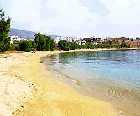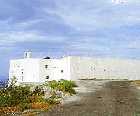Serifos Characteristics

 Serifos, with
a population of 1,500, lies 73 nautical miles from Piraeus. Serifos
has a land mass of 73 sq. km and its coastline is 70 km. long. Serifos'
closest Cycladic neighbor is Sifnos. In antiquity the island was
a prosperous iron and copper mining center which minted its own
frog-embossed coinage.
Serifos, with
a population of 1,500, lies 73 nautical miles from Piraeus. Serifos
has a land mass of 73 sq. km and its coastline is 70 km. long. Serifos'
closest Cycladic neighbor is Sifnos. In antiquity the island was
a prosperous iron and copper mining center which minted its own
frog-embossed coinage.
Island Features

 Serifos has
sandy beaches but is quite barren. However, Serifos has its own
unique species of the Carnation. Sirifos also grows olives and
almonds.
Serifos has
sandy beaches but is quite barren. However, Serifos has its own
unique species of the Carnation. Sirifos also grows olives and
almonds.
The sea around Serifos is clean
and the fish fresh and relatively inexpensive. Livadi is the greenest
spot on the island and where many Germans and French tourists like
to visit in summer. Many yachts moor within the protection
of the harbor. The islands hilltop village of Hora has a Byzantine-Venetian castle. There is also a stalactite cave
and Greek Orthodox Monastery. Serifos makes it own wine from the
hardy rhodites grape.
All the beaches are accessible on foot and are unspoiled.
Towns
 Livadi, set in a beautiful,
well-protected, wide semicircular bay boasts Serifos most amenities
with quite a few rooms to let and several hotels. Nightlife is
most apparent in the port of Livadi. You can make out
the town and dock below in the picture at left. There's a sizeable yacht marina in Livadi.
Livadi, set in a beautiful,
well-protected, wide semicircular bay boasts Serifos most amenities
with quite a few rooms to let and several hotels. Nightlife is
most apparent in the port of Livadi. You can make out
the town and dock below in the picture at left. There's a sizeable yacht marina in Livadi.
The further along
the long combination sand and pebble beach you go, the less expensive
the rooms and tavernas become. Within easy walking distance from Livadi is the crowded Livadakia beach. Thirty minutes south of Livadi is the Karavi Beach, which is popular with nudists. To the east is the beach at Lia.
High on the hill 6km above stands the dazzling white Hora, (pop. 400) one of the prettiest Cycladic island towns.
You can take the bus or climb ancient stairs. Its narrow alleyways and serpentine paths were made purposefully confusing
to foil pirate attacks. The town hall contains a small collection
of archeological finds from around the island. It has its own small
Venetian Castle, now in ruins. Many of Hora's cube-shaped homes are built of stone taken from the caste. Hora is barren and rocky, but geranium trees grow there, some as much as 12 feet high! In the spring, the rare carnation that grows only on Serifos may be seen in Hora.
The view from the crag that Hora clings to is breathtaking. The the view of Hora from afar is equally charming, with its whitewashed stone.
A 20 minute walk northeast (there's also a road) is Psilli Amos beach, one of the islands' nicest.
Beyond Hora

 The
road continues beyond Hora on to Megalo Horio or Big Village which is considered
the location of the ancient Serifos capital. It is the center of the old mining
district and has a beach below called Megalo
Livadi or Big Prairie where the ore used to be loaded for export.
The
road continues beyond Hora on to Megalo Horio or Big Village which is considered
the location of the ancient Serifos capital. It is the center of the old mining
district and has a beach below called Megalo
Livadi or Big Prairie where the ore used to be loaded for export.
From Megalo Horio the road continues to Koutalas and its 6th Century
marble Kastro ths Grias or ''Castle of the Old Lady."
Nearby is the Cave of the Cyclops discovered during mining operations. The cave has a small lake and two stalactite chambers (bring your own flashlight).
There are two smallish beaches close by, Ganema and Malliadiko. From here you can follow a path back to Livadi.
 From Hora a paved road
descends past Panagia village with the islands oldest church–built in the 10th Century.
From Hora a paved road
descends past Panagia village with the islands oldest church–built in the 10th Century.
At Galani is the17th Century Monastery of the Taxiarchos or Monastery of the Archangels. This is the most important monument on the island. This church contains a precious altar, frescoes by the famous painter Skordilis and Byzantine manuscripts.
The
road continues to the island's little fertile corner, the wine-producing Kalitsos district. Kalistsos
also features almond and olive orchards. Plati Giallos beach is just past the Monastery and on the other side of Galani is Sikamia
Bay with a beach, taverns, shade and fresh water.
Drinking and Dining
In LIvadi, for non-Greek
dishes try Mokka Restaurant at the end of the port with an eclectic
mix of Greek and foreign clientele and even, on a good night, Indian
style chicken and saag paneer.
Serifos is a small undeveloped island with little in the
way of luxury hotels although there are several smaller pleasant
ones which fill up in the summer.
History
One of the oldest Greek myths is set on Serifos. According to Greek
myth Perseus, slayer of Medusa, was born here and grew to manhood
after arriving on a bladder or in a box with his mother Danae. They
were fleeing the wrath of Arkisius, King of Argos, her father. Soothsayers
foretold to Akrisius that he would be slain by her son. So he locked
her in a tower away from men. But she, being so comely, attracted
Zeus himself who, in a shower of golden rain, fathered Perseus. Akrisios set mother and son adrift in a chest, which Zeus is purported to have guided to Serifos.
When the mother and son first arrived
on the island they were taken in by the kindly fisherman who
took them to the King Polydectes who also wanted to marry Danae but
was rebuffed. As Perseus grew to manhood he defended his mothers decision
not to marry, so the King came up with the idea of sending him off
to accomplish some tasks. The first one was to bring him the
head of Medusa, the only mortal sister of the three Gorgon Sisters,
with hair made of living snakes, bulging eyes and fang-like teeth.
Perseus, having God as his father
and being no slouch, had the help of the Goddess Athena, who fitted
him out with a mirrored shield, winged shoes and a cloak of invisibility.
With the head in a bag, and after a side trip to save and dally with
Andromeda, Perseus returned to Serifos, and showed Medusa's head to
the king and his court who immediately turn to stone. The kindly fisherman
became King and Perseus and Danae returned home to Argos causing Arkisius
to skeedaddle out of town. The prophecy was fulfilled when Perseus accidentally put a javelin through the
foot of his grandfather,
who expired on the spot.
Serifos' history after all this
is pretty bland and has the usual Ionian, Athenian, Delian, Persian,
Phoenician, Macedonian, Roman, Byzantine, Venetian (The Micheli Family),
Turkish, Russian (1770-1774), Nazi and Italian cast of characters
common to the rest of the Cyclades.
More recently many islanders have immigrated
abroad and to Athens.




